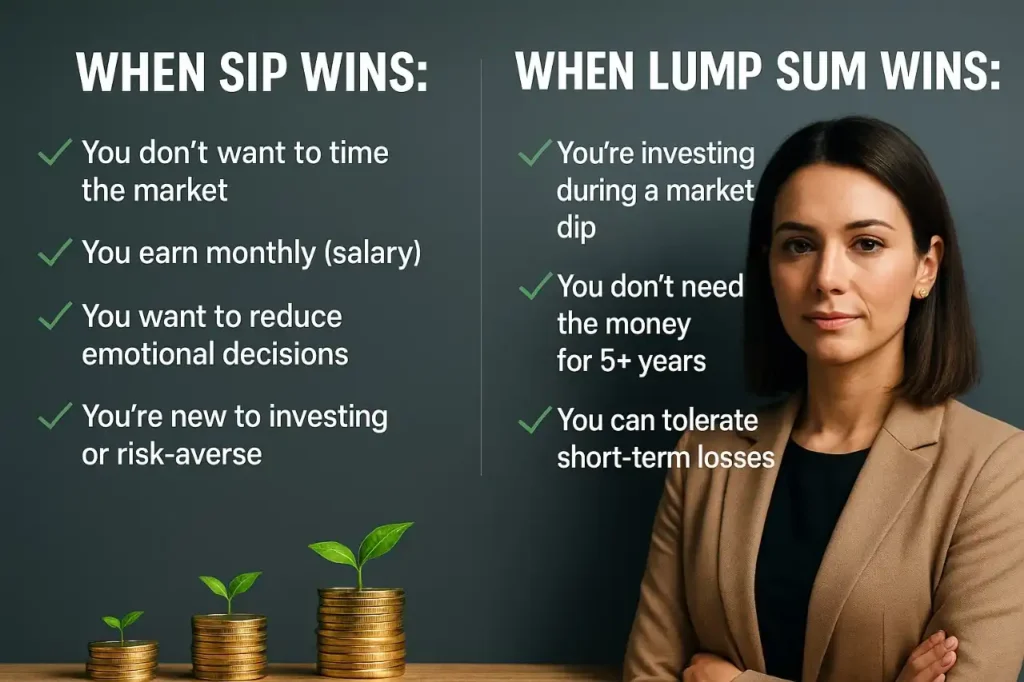“You don’t need to be smarter than the rest. You need to be more disciplined than the rest.” — Warren Buffett
If you’ve ever saved up a few thousand dollars and thought:
Should I invest all at once or go slow with monthly contributions?
.…then congratulations—you’re asking the right question.
Welcome to the classic debate between: (SIP vs Lump Sum)
SIP (Systematic Investment Plan) — slow and steady
Lump Sum Investment — go big or go home
In this comprehensive guide, you’ll learn:
✅ The mechanics of both strategies
✅ Real-world examples with dollar figures
✅ How psychology plays a bigger role than math
✅ When each strategy is best for you
✅ How to combine both for maximum returns
Let’s break it all down.
💡 SIP vs Lump Sum: What They Really Mean
| Feature | SIP (Systematic Investment Plan) | Lump Sum Investment |
|---|---|---|
| Definition | Fixed amount invested monthly | Entire amount invested at once |
| Best For | Salaried or consistent earners | Windfalls (bonus, sale, inheritance) |
| Market Timing | Irrelevant—averages cost | Critical—timing impacts outcome |
| Risk Exposure | Lower (phased entry) | Higher (front-loaded risk) |
| Return Pattern | Smooth over time | Volatile short-term, higher long-term |
| Discipline Level | Automated (set and forget) | Manual (emotion-dependent) |

💰 Real Example: You Have \$12,000 — What Now?
Let’s imagine you have $12,000 to invest.
Should you invest it all right now, or split it into $1,000/month for 12 months?
Assumptions:
Investment horizon: 5 years
Expected annual return: 12%
SIP duration: 12 months, then let it grow
🅰️ Option 1: Lump Sum Investment
Formula:
A = P × (1 + r)^n
OR You can use Mutual Fund Calculator
Where:
P = $12,000
r = 0.12 (12% annual return)
n = 5 years
A = $12,000 × (1.12)^5 ≈ $12,000 × 1.7623 = $21,148
🎯 Final Value = $21,148
✅ Higher potential return
🚩 Risky if market drops soon after entry
🅱️ Option 2: SIP of $1,000/month for 12 Months
Here’s where it gets a little tricky.
Each $1,000 investment grows for a different number of months.
Let’s simplify using an online SIP calculator with:
Monthly return = 1% (i.e., 12% annually)
SIP: $1,000/month for 12 months
Then let total corpus grow for remainder of 5 years
📊 SIP Corpus after 12 months ≈ $12,809
📈 Growth of $12,809 for 4 more years @ 12% = $20,155
🎯 Final Value = $20,155
✅ Safer entry
🚩 Slightly lower return
📊 Final Comparison: SIP vs Lump Sum
| Strategy | Final Value | Return Potential | Volatility | Emotional Comfort |
|---|---|---|---|---|
| Lump Sum | $21,148 | Higher (if timed well) | High | Low |
| SIP | $20,155 | Smoother | Low | High |
👉 In this case, lump sum earns $993 more, but at a higher emotional cost.
🧠 It’s Not Just About Math—It’s About Behavior
The reason most people do not get wealthy is not because they picked the wrong stock.
It is because they panicked and sold too early.
Lump sum investing requires nerves of steel.
SIP allows you to build wealth without overthinking or watching the news daily.
Question: Can you stomach a 20% dip right after you invest $12,000?
If the answer is no—SIP is likely your better choice.
🔥 When Lump Sum Is a Smart Move
Lump sum investing works best when:
✅ You’re investing during a market dip
✅ You don’t need the money for 5+ years
✅ You can emotionally tolerate short-term losses
✅ You are confident in long-term growth
📍Example:
You receive a $20,000 inheritance in 2020 during COVID-19 market crash.
You invest it all in a total market ETF.
By 2023, it grows to $34,000+ — outperforming any SIP strategy in the same period.
🌱 When SIP Is Your Superpower
SIP works best when:
✅ You earn monthly (salary/freelance income)
✅ You want to reduce emotional decisions
✅ You’re new to investing or risk-averse
✅ You want to build a lifelong habit
📍Example:
You invest $500/month for 10 years in a diversified mutual fund @ 12% CAGR.
Future value ≈ $103,000 from just $60,000 invested.
No lump sums. No stress. Just consistency.

🧮 What Does History Say?
| Strategy | CAGR (2013–2023) | Max Drawdown | Smoothness |
|---|---|---|---|
| Lump Sum | 13.5% | High | Low |
| SIP (DCA) | 12.1% | Lower | High |
Look above at 10-year market data from the S&P 500:
Key takeaway:
Lump sum often edges out SIP in bull markets
But SIP wins psychologically and during sideways or volatile markets
👨🌾 Real-World Analogy: Farmer vs. Hunter
- Lump Sum = Hunter
Waits for the perfect shot. Risky but rewarding if timed right.
- SIP = Farmer
Plants every month. No fireworks. Just patience and harvest.
Which one fits your personality better?
🔄 The Hybrid Approach: Best of Both Worlds
Why not use both strategies?
✅ Use Lump Sum when:
– The market dips 10–20%
– You receive a windfall (bonus, tax refund)
✅ Continue SIP:
– For long-term discipline
– For cost averaging
– To stay invested during emotional times
📍Example:
You receive a $5,000 bonus.
You also invest $300/month via SIP.
Now you’re compounding from both ends.
This combo strategy gives you:
– Flexibility
– Higher upside during dips
– Ongoing investment behavior
💬 Self-Assessment: What’s Right for You?
Ask yourself:
1. Do I have a large amount ready to invest?
2. Can I stomach a short-term 20% dip?
3. Is my investment horizon > 5 years?
4. Will I stop investing if markets fall?
5. Do I prefer automation over timing?
🎯 If you said YES to 1–3 → Lump Sum may suit you
🎯 If you said NO to 4–5 → SIP is a smarter fit
Still unsure? Blend both.
🧠 SIP Tools You Can Use
Use these tools to visualize your future:
💻 Understand SIP > Systematic Investment Plan: What is SIP? and How SIP works?
–> SIP Calculator > SIP Wealth Calculator – The Fit Finance
💻 DCA vs Lump Sum Calculator – Personal Capital
💻 Understand MF > Mutual Funds Made Easy~ How to Grow Your Wealth Without the Headache
–> MF Calculator > Mutual Fund Calculator – The Fit Finance
Run numbers. Test scenarios. Build conviction.
🔐 Psychological Advantage: SIP Encourages Consistency
SIP doesn’t just average costs.
It trains your behavior.
– Less decision fatigue
– Lower stress during market crashes
– More financial discipline
– Better long-term wealth outcomes
You don’t need timing skills.
You need habits.
📌 Recap: SIP vs Lump Sum at a Glance
| Factor | Lump Sum | SIP |
|---|---|---|
| Best Time | During market dips | Anytime |
| Risk Level | High | Moderate |
| Return Potential | Higher (if timed well) | Stable |
| Emotional Fit | Aggressive investor | Conservative/Disciplined |
| Ideal Scenario | Windfall | Monthly salary |
| Automation | No | Yes |
📈 Final Verdict: SIP vs Lump Sum?
🎯 Want to invest a windfall in a down market? → Choose Lump Sum
🎯 Want to build wealth slowly and safely? → Stick with SIP
🎯 Want the best of both? → Use both!
But the worst choice?
👉 Doing nothing.
Start small. Stay consistent. Let time and compounding do the heavy lifting.







